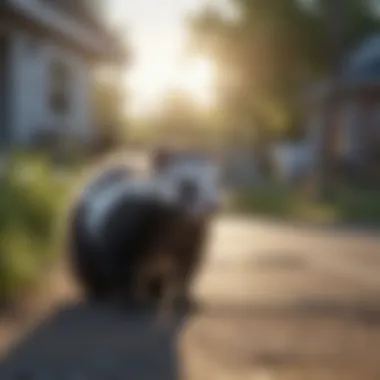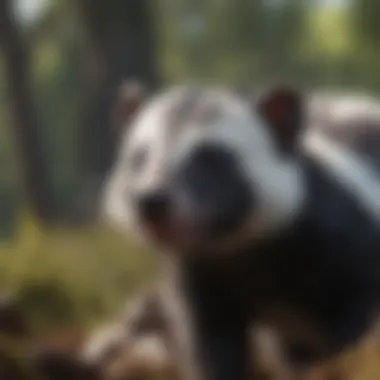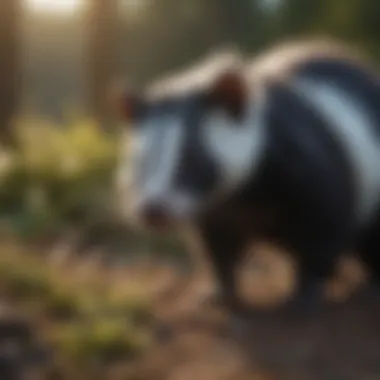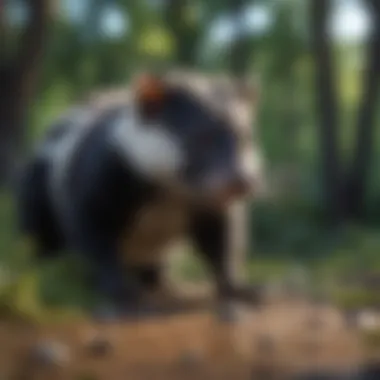Dead Skunk Removal: A Comprehensive Wildlife Management Guide


Preface
The presence of dead skunks in urban and suburban areas can pose significant challenges for communities. These animals, while part of the local ecosystem, can create hygiene concerns and attract pests. Understanding the procedures for dead skunk removal is essential for wildlife management and public health. The processes involved not only contribute to environmental management but also serve to mitigate health risks for residents.
Recognizing the significance of this issue warrants addressing the relationships between humans and wildlife. As cities grow, encounters between these two worlds become more frequent. Caring for the local environment involves responsibly managing wildlife, including the removal of deceased animals. Proper removal helps maintain safety, aesthetic appeal, and ecological balance in our communities.
Current Status and Challenges
Dead skunks can often be found in various locations, ranging from backyards to roadways. Their decomposing bodies lead to the potential spread of diseases, including rabies, leptospirosis, and other zoonotic infections. The presence of a dead skunk poses not only a health risk but also an environmental one. They attract predators and scavengers, which may disturb local wildlife.
A significant challenge is the reluctance of individuals to manage the removal process because of the associated sensory unpleasantness. Dead animals emit strong odors and can create distress within a community. Local governments may struggle with proper response initiatives due to limited resources or lack of public awareness regarding procedures.
Sustainable Solutions
To mitigate issues surrounding dead skunk removal and management, sustainable solutions must be explored. Public education remains crucial. Informing residents about identification and reporting can help address the problem proactively. This not only helps in timely removal but also increases awareness about wildlife, thereby fostering coexistence.
There are organizations and local wildlife services dedicated to anonymous reporting methods or community-driven response initiatives. For instance, a successful example comes from Redmond, Washington, where community education programs have significantly improved reporting rates of dead animals, allowing for resource managers to handle issues swiftly. Alternatives to traditional methods include composting or operational responses that follow animal-friendly practices, ensuring overall health and balance within the local ecology.
Impact and Importance
The impact of improper dead skunk management can ripple through neighborhoods, affecting both ecological systems and human health. Communities may encounter secondary pests or viruses if diseases spread unchecked. Additionally, inappropriate disposal practices create polluting issues and impact other wildlife.
Conservation efforts play an essential role in ensuring the coexistence of urban areas with wildlife. Thus, prioritizing ethical and effective management of wildlife disturbances is imperative for future generations.
Routine training for local health officers regarding wildlife management resources contributes to better practices. Implementing regular workshops can spread knowledge and change perceptions surrounding wildlife interactions.
The sustenance of ecosystem wellness not only favors wildlife but equally benefits residents. Ultimately, taking taking deliberate action on these fundamental issues shows respect for nature as well as an appreciation for public health practices.
Understanding the Problem of Dead Skunks
The presence of dead skunks in urban and rural environments presents a distinct challenge that needs consideration. Understanding the problems surrounding dead skunks is crucial for maintaining public health, environmental cleanliness, and local wildlife management strategies. When a skunk dies, it can contribute to various hazards. The decay process attracts other wildlife, which may worsen issues associated with disease transmission.
The Relevance of Dead Skunk Removal
The removal of dead skunks is not merely a matter of aesthetics; it is fundamentally concerned with health safety and ecological balance. Dead skunks can harbor diseases like rabies or leptospirosis. Failure to remove these carcasses can result in these diseases spreading to other animals or even humans. Moreover, dead skunks generate unpleasant odors that degrade the quality of life in nearby neighborhoods. Effective removal mitigates these risks.
In essence, prioritizing dead skunk removal aids in maintaining the health of both residents and the ecosystem. As such, understanding the implications of leaving a carcass unattended can lead to more informed and proactive community responses.
Common Locations for Dead Skunks
Identifying where dead skunks are likely to be found expedites response efforts. Common locations include:
- Roadways: Many skunks are frequently killed by vehicles. Roads are often littered with wildlife casualties, making them hotspots for dead animals.
- Backyards: Urban settings sometimes attract skunks that die unexpectedly in people’s yards, affecting local residential areas.
- Parks and Wildlands: These places are natural habitats for skunks and can consequently become sites of decay due to population density.
Knowing these locations can help community leaders organize clean-up standards and educate the public on immediate reporting processes.


Signs of a Dead Skunk
Recognizing the signs of a deceased skunk is fundamental for prompt removal. Common indicators include:
- Unusual Odor: A strong, decomposing smell is often the first clue.
- Physical Appearance: Signs of decay such as bloating or discoloration can be seen.
- Location: If a skunk is found in an unusual spot, it might indicate a deceased animal that needs attention.
- Attracting Other Wildlife: If carnivorous animals congregate around a particular area, it may signify the presence of a dead skunk.
Awareness of these symptoms is essential for local residents and can massively help maintain the health and welfare of communities. Additionally, this knowledge forms the base for future educational opportunities that can further improve understanding among the public.
Health Risks Associated with Dead Skunks
The presence of dead skunks poses significant health risks that merit considerable attention in wildlife management. These risks can impact not just individual residents or property owners but extend to community health at large. Understanding the dangers associated with dead skunks is crucial for effective management and prevention strategies. In this section, we will explore the potential diseases transmitted by dead skunks and their impact on local ecosystems.
Potential Diseases Transmitted
Dead skunks can be a source of various zoonotic diseases, which are diseases that can be transmitted from animals to humans. One of the notable diseases associated with skunks is rabies. Rabies is a viral disease that affects the centralized nervous system and ultimately leads to death if proper medical intervention is not received promptly. Although rabies is primarily spread through bites, the carcass of a rabid skunk may harbor the virus.
Another concern involves leptospirosis. This bacterial infection can be transmitted through contact with infected animals or their bodily fluids, often found in decaying wildlife. It can lead to organ failure and severe illness in humans if contracted. Additionally, dead skunks can attract various scavengers, which may be carriers of different pathogens that can pose a further risk to human health. The potential for such diseases reflects the necessity of professional intervention and safe removal processes.
Impact on Local Ecosystems
The presence of a dead skunk can disturb local ecosystems in several ways. First, decomposing carcasses emanate strong odors that may attract predators and scavengers, which disrupts the established food chain and alters animal behavior. For example, opportunistic feeders like crows or raccoons may proliferate, overshadowing native species.
Moreover, the decay process itself can negatively affect soil quality and introduce pathogens to the surrounding environment, leading to possible contamination of nearby water sources. This can imperil not just animal populations but can also affect local flora, curbing their health and development.
Maintaining a balanced ecosystem requires active management of wildlife hazards, and removing dead skunks plays an important role. Hence keywords like “dead skunk risks” should be interwoven into discussions about wildlife disturbances to enhance awareness in communities serving as habitats for such animals.
Taking quick action towards dead skunk management is vital to avoid potential illness and environmental degradation. As a community, awareness and proactivity can lead to safer living conditions.
Legal Considerations in Skunk Removal
Addressing the death of skunks at local level involves important legal considerations. With both urban and rural settings experiencing wildlife disturbances, having clarity on regulations aids in managing these situations. Understanding the legal frameworks surrounding dead skunk removal ensures that individuals act within the law while prioritizing public safety and environmental conservation. Careful navigation of these aspects can help prevent unnecessary disputes and promote effective wildlife management practices.
Local Regulations
Local regulations vary widely. They can reflect the characteristics of the area. Many municipalities have specific ordinances regarding wildlife removal. Familiarity with these rules can prevent legal repercussions against homeowners and businesses.
Common points that tend to be outlined in local regulations include:
- Permit requirements: Some regions may require a permit for the removal of dead animals.
- Reporting protocols: Many laws dictate that authorities must be notified when a dead wildlife incident occurs, often to mitigate health risks.
- Timing and methods: Local laws might dictate how long a dead skunk can remain in a public space before authorities must take action, along with allowable removal methods.
It becomes essential to check local government websites or reach out to wildlife control services for clarification.
Environmental Protection Laws
Protection of the environment is paramount when it comes to handling deceased wildlife. Federal laws often intersect with local regulations surrounding dead animal removal. Understanding these guidelines is crucial not only for compliance but also for maintaining ecological integrity.
Key objectives of environmental protection laws regarding dead skunks include:


- Protecting local wildlife: Removal methods need to be humane and won't negatively impact existing wildlife species.
- Preventing contamination: Key laws focus on preventing dead animals from contaminating soil or water supplies. Dangerous pathogens could spread through improper disposal.
- Balancing ecosystem: Regulators consider how the removal affects local ecosystems, such as whether predator-prey dynamics distort if species populations shift due to excessive removals.
When addressing skunk removal legally, it is advisable to consult resources, attorneys, or local wildlife agencies. Engaging in dialogue with officials fosters a better understanding of the complex legal landscape that governs wildlife disturbances.
Steps for Effective Dead Skunk Removal
Removing a dead skunk from your environment is crucial for multiple reasons. First, it is a question of public health. Skunks can carry diseases, and their carcasses become breeding grounds for pathogens. Second, proper removal practices protect the ecosystem balance. When an animal dies, various scavengers may be attracted, potentially causing disruption. An effective removal process minimizes these risks and keeps your surrounding safe.
Preparation and Safety Measures
Before beginning the dead skunk removal task, preparation is key. It is crucial to equip yourself with the necessary materials, which may include gloves, masks, and heavy-duty bags. These materials provide essential protection from exposure to diseases. Also, inform someone of the removal process, ensuring you are not alone. Having a secondary person can serve as assistance or a relay for actions requiring someone else’s aid.
Safety protocols include evaluating the site where the skunk was found. Look for any hazards, like potential traffic if near a road. Determine if the animal poses any risk of being an ordinance from local wildlife authority. Proceed only if all conditions indicate safe action.
Proper Handling Procedures
When handling a dead skunk, using correct techniques is necessary. Start by carefully placing your gloves on, ensuring a good fit. Do not touch the animal directly without the gloves. It's advised to keep your body as far away as possible, using tools like shovels whenever necessary. Placing the skunk in a heavy morphological bag should occur without direct contact to avoid contaminants across clothing or skin.
Always observe proper lifting techniques when transporting the skunk to avoidstrain-related injuries. Once placed in a handbag, check if it seals well. The excretions from a dead animal can leak easily, potentially contaminating other areas or directly impacting human health.
Disposal Methods
Disposal of a removed dead skunk must follow environmental and health regulations, ensuring the dead body does not become an ongoing problem. Several disposal methods exist, and knowing the ideal options is paramount.
- Local Regulations Compliance: Check with local waste management for specific disposal options.
- Burial: Digging deep holes away from water sources allows for a natural decay process. Correct techniques must assure that other wildlife doesn’t become a disturbance later.
- Incineration: Some facilities may allow for incineration, reducing the chances of spreading disease through decomposing carcasses.
Surrounding environment considerations remain vital. Always enforce a responsible method to avoid impacting human health or local ecology negatively.
Professional Skunk Removal Services
Addressing the issue of dead skunks requires not only the right knowledge but also sometimes professional help. Professional skunk removal services play a vital role in ensuring that these situations are processed safely and effectively, particularly in urban and suburban environments. Their expertise not only aids in reducing health risks associated with the presence of dead animals, but also respects local regulations and environmental guidelines.
When to Call Professionals
Determining the right moment to enlist professional help can be complex. Several factors should inform this crucial decision:
- Severity of the Situation: If the dead skunk is in a location that employees hazardous handling, it is best to relay this task to the experts.
- Health Risks: Encountering a dead skunk in close vicinity to where people and pets gather warrants immediate professional intervention. Potential disease transmission is a substantial concern.
- Legal Regulations: In certain areas, there are explicit regulations governing wildlife disposal. Failing to comply may lead to unintended legal repercussions.
- Emotional Distress: For some, dealing with wildlife carcasses is unsettling. Reaching out to professionals who can address the problem takes this burden away.
Choosing the Right Service Provider
When engaging professional services for skunk removal, it is critical to choose the right provider. Below are some essential considerations to guide your decision:
- Licensing and Accreditation: Ensure any service provider possesses the required licenses and certifications— this may include proper permits to transport dead wildlife.
- Experience and Expertise: Select a provider with experience specifically in wildlife removal. Skills and knowledge about dealing with skunks can affect the meticulousness and safety of the job.
- Reviews and Recommendations: Consult reviews from previous clients, and when possible, reach out to individuals who have used the service. Positive experiences can provide confidence in your chosen provider's reliability.
- Cost Transparency: When getting estimates, providers should be clear about costs and any additional fees for removal services. Understanding the financial implications ensures there are no unforeseen expenses.
Considering these points can lead to an informed choice and effective resolution of a challenging issue.


Aftercare Following Dead Skunk Removal
After successfully removing a dead skunk, aftercare is critical in maintaining a safe and healthy environment. This phase involves sanitizing the area and monitoring for further wildlife encounters. Both steps are not just recommended, they serve as essential practices for preventing future problems and ensuring public health.
Sanitizing the Area
Once the skunk is removed, the area where it was found must be thoroughly sanitized. This process involves several steps:
- Wear Protective Gear: Begin by putting on appropriate protective clothing, such as gloves and masks. This minimizes direct contact with any potential pathogens.
- Clean the Surface: Use a suitable cleaning solution, such as a mixture of water and bleach, to scrub any surfaces the deceased animal may have contaminated. Focus especially on soil and hard surfaces.
- Odor Removal: Dead skunks can leave a lasting odor. Using odors specific neutralizers or solutions containing baking soda can be particularly effective in masking unpleasant smells.
- Inspection for Residue: After initial cleaning, inspect the area for any remaining signs of the skunk, such as bodily fluids. If found, repeat the cleaning process again.
"Proper sanitation minimizes health risks and helps restore the area to its pre-incident condition."
Taking these measures not only promotes hygiene but also discourages other wildlife from frequenting the same spot, thus reducing the chances of further animal disturbances.
Monitoring for Further Wildlife Encounters
Post-removal monitoring is equally vital and should not be overlooked. Wildlife may return to the area, drawn by food sources or other animals' scents. To effectively monitor the situation:
- Check Regularly: Conduct daily inspections of the area for new signs of wildlife presence. Look for tracks, droppings, or any disturbances which indicate animal activity.
- Adjust Surrounding Habitat: If frequent wildlife encounters continue, take steps to modify the environment. Remove food sources such as unsecured garbage or pet food left outdoors.
- Rodent Control Measures: Employ methods to keep rodent populations in check, as an influx of rodents can encourage predators like skunks to revisit the area.
- Community Awareness: Engage with local residents regarding signs of wildlife returning and encourage them to keep an eye on dubious activities. Community engagement can play an important role in proactive wildlife management.
Continual monitoring will help to identify any recurrence of wildlife disturbances early, allowing for swift remedial actions. By implementing these aftercare steps, one can ensure that the ecosystem remains balanced, safe, and health-complying.
Preventing Future Incidents
Preventing the occurrence of dead skunks in urban and suburban areas is critical for maintaining public health and safety. By taking the right steps, communities can minimize encounters with skunks and other wildlife. The benefits of prevention are vast, including decreased health risks, improved community aesthetics, and a better understanding of local ecosystems.
Habitat Modification Techniques
One effective strategy for preventing future incidents is habitat modification. This involves changing the environment to make it less attractive for skunks and similar creatures. Simple techniques include:
- Removing food sources: It’s essential to keep garbage securely closed and to clean up pet food left outdoors. Eliminating bird seed spills can also deter birds which, in turn, attract predators like skunks.
- Securing property: Close any gaps or holes in fences and walls that could allow skunks and other wildlife to enter backyards. Bird netting installation can help prevent access to gardens.
- Landscaping choices: Favor landscaping plants that do not produce food attractive to skunks, such as fruits or nuts. Instead, use thorny bushes that can act as a barrier.
- Chemical deterrents: While some communities may utilize these sparingly, adopting natural barrier techniques can be seen as more environmentally-friendly.
These modifications create an unfriendly environment for skunks and abruptly reduce their chances of settling in your area.
Community Engagement and Awareness
For effective wildlife management, community engagement is vital. An informed and cooperative community can tackle issues related to skunks and other wildlife. Key initiatives may include:
- Educational programs: Workshops can educate local residents on the importance of not feeding wildlife intentionally or unintentionally. Understand the impact of human actions on wildlife behavior.
- Neighborhood efforts: Encourage community members to participate in clean-up events or monitoring efforts to reduce food sources for wild animals.
- Reporting mechanisms: Establish quick-response protocols for sightings of dead skunks or any wildlife disturbances. Reporting can help local authorities respond efficiently.
Culmination
In the urbanized world, managing wildlife encounters, particularly the events surrounding dead skunk removal, stands as a critical concern. This article emphasizes the essential processes involved in removing dead skunks and the related health risks that arise. Understanding how to approach these situations can foster a healthier community environment.
Summarizing Key Points
The key aspects explored in this article include:
- Understanding the Problem of Dead Skunks: Recognizing both the relevance and common locations for dead skunks aids in addressing the issue.
- Health Risks: Dead skunks pose health threats, potentially transmitting diseases that affect both humans and pets.
- Legal Considerations: Familiarity with local regulations regarding wildlife disturbances guides responsible actions in managing dead animal removals.
- Effective Removal Steps: Details on preparing, safely handling, and disposing of dead skunks ensure effective removals that prioritize safety all around.
- Professional Services: Knowing when to contact professional wildlife handlers can ease the burden of removal significantly.
- Aftercare Practices: Post-removal sanitary measures are crucial in preventing further disturbances or hazards.
- Future Prevention Strategies: Implementing habitat modification and community awareness are vital for reducing similar incidents in the future.
The Importance of Responsible Wildlife Management
Responsible wildlife management is crucial not only to public health but also to ecological stability. It requires a level of community involvement and awareness that ensures wildlife disturbances are managed efficiently. Reducing the possibility of dead skunks in residential areas reduces disease risk and increases community comfort levels.



